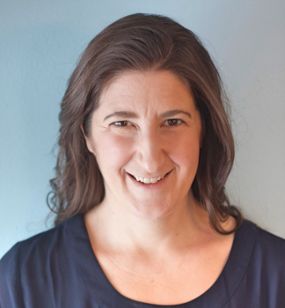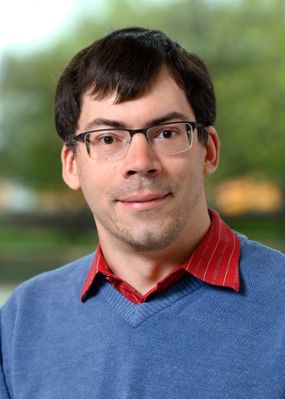Two MSU mathematicians awarded collaborative NSF grants
Michigan State University is two for two in 2021 when it comes to the National Science Foundation’s (NSF) highly competitive Focused Research Group (FRG) grant. MSU mathematicians Teena Gerhardt and Ilya Kachkovskiy, in collaboration with principal investigators (PIs) from institutions across the country, will use the 3-year grants to advance research in some of the most exciting questions in topology, geometry and mathematical analysis.
“It is a great honor, and a testament to the excellence of our faculty, that we have two researchers serving as PIs on the first two FRGs announced this year,” said Keith Promislow, professor and chair of the Department of Mathematics in the College of Natural Science. “FRGs are highly competitive grants that showcase the future of mathematical research.”

“This is the first time I have applied for one of these collaborative research grants, and I am very excited to work with PIs from different institutions who I have known and respected for a long time,” said Gerhardt, associate professor, about the FRG totaling over $1 million. “The team was assembled with collaboration in mind, bringing different expertise, techniques and perspectives to this work, and it should be really interesting.”
Gerhardt is an expert in algebraic K-theory, a rapidly growing area of study that lives at the intersection of algebra, topology and number theory. Gerhardt studies K-theory from the perspective of topology, which is sometimes described as “rubber sheet geometry” because it studies the properties of shapes that are unchanged by continuous deformations like stretching and bending.
K-theory’s flexibility makes it applicable to a diverse set of mathematical problems, but only recently was it shown to be fundamentally connected to the 120-year-old program of scissors congruence and cut-and-paste geometry. When two polyhedra in 3-dimensional space are “scissors congruent,” one can be made from the other by cutting it into smaller polyhedra and reassembling the pieces in a new way.
“The grant will develop new applications of tools from algebraic K-theory to a variety of problems in topology and geometry,” said Gerhardt, who will collaborate with 8 other PIs from across the United States—the University of Pennsylvania, Cornell University, Columbia University, Indiana University, Vanderbilt, UCLA, Binghamton University SUNY, and the University of Kentucky. Their efforts will develop the budding connection between algebraic K-theory and cut-and-paste geometry, significantly advancing research in both areas.
The grant will also provide extensive networking opportunities for graduate students and postdocs. Each graduate student will be paired with a PI from a different institution to provide invaluable input on thesis research and help review job materials. Graduate students and postdocs will also participate in monthly virtual group meetings, a summer school at UCLA in 2022, a collaborative research workshop at Cornell in 2023 and a 2024 conference at the University of Pennsylvania.

Ilya Kachkovskiy, assistant professor, will use the 3-year FRG totaling $1.4 million to advance an already fruitful collaboration with his former advisor, Svetlana Jitomirskaya at the University of California Irvine, and Wencai Liu at Texas A&M. Their aim is to expand new methods for analyzing small denominator problems in order to address unanswered questions related to quasiperiodic motion.
“We want to understand how often and in what pattern a quasiperiodic system would return to a state that is very close to the initial state,” Kachkovskiy said. “Traditionally, these problems have been approached by Kolmogorov-Arnold-Moser (KAM)-type techniques, but in the setting of multi-dimensional quasiperiodic operators, these techniques have limitations.”
Quasiperiodic motion is threaded throughout nature, including the motion of planets, population dynamics in biology and quasicrystals found in solid state physics. Kachkovskiy explained that unlike periodic motion, where an object returns to its initial state after a specified period, quasiperiodic motion involves two or more patterns of asynchronous behavior that may influence each other. Because of this, the objects are destined never to return to their original state but come so close that scientists are in search of new methods to analyze it.
Kachkovskiy and his team will expand methods developed as part of his 2019 CAREER Award to construct solutions to these extremely complex, nonlinear equations that Kachkovskiy explains as “complicated enough that one person cannot do it.”
The grant also provides funding for one or two postdocs who will have the invaluable opportunity to travel and interact with all three PIs.
“Receiving this grant means that the area our team is working in is in high demand,” said Ilya Kachkovskiy, “We aim to use ninety percent of the money to support graduate students and postdoctoral scholars whose job market during the pandemic became very chaotic, so we see it as an opportunity to bring new, strong junior researchers into the area. Because of the team activities, they will have access to and collaborate with three PIs, rather than just one mentor.”
For more details about these two grants, please visit here for Gerhardt’s grant and here for Kachkovskiy’s grant.
Banner image: MSU mathematicians Teena Gerhardt and Ilya Kachkovskiy, in collaboration with principal investigators from institutions across the country, will use 3-year National Science Foundation Focused Research Group (FRG) grants to advance research in some of the most exciting questions in topology, geometry and mathematical analysis. Credit: (left image) Teena Gerhardt; (right figure) S. Jitomirskaya, W. Liu, “Universal hierarchical structure of quasiperiodic eigenfunctions”, Ann. Math. 187 (2018), no. 3, pp. 721-776.